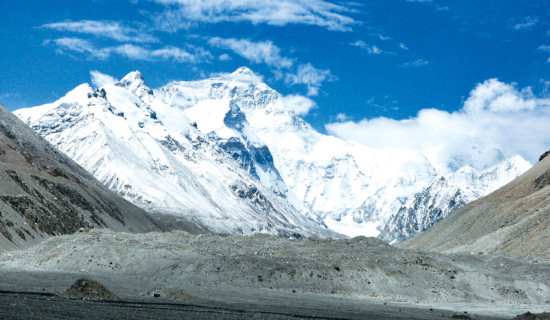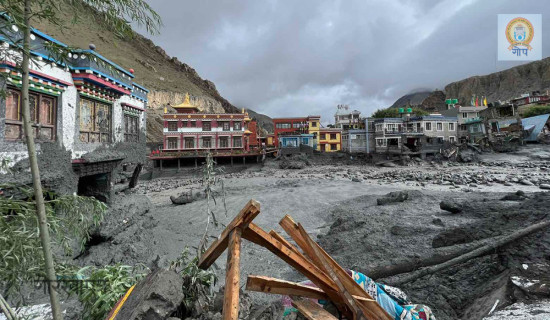- Wednesday, 10 December 2025
Nepal has mountain tall vulnerability
International Mountain Day 2023 is going to be marked on Monday (December 11) with the theme ‘Revitalising Mountain Ecosystems’. This year's event urges the pro
Hindu Kush Himalaya is resource hub: President
President Ramchandra Paudel has said that the Hindu Kush Himalayan region is a crucial asset not only for this region, but also for the entire world – in terms of sources of food, energy, water, and cultural and biological diversities.
Melamchi water supply to resume soon
The long-awaited supply of water from Melamchi is set to begin very soon, following the clearance of debris that has accumulated inside the water supply headworks. The access road to the Melamchi headworks will be completed within a few days, then the contractor will proceed to the site to clear the debris piled up due to the monsoon rains this season, said Padam Kunwar, Senior Division Engineer.
Melting glaciers: Nepal in climate hot spot
As the temperatures continue their relentless rise on a global scale, the majestic glaciers of the Himalayas are undergoing an yet alarming transformation. These frozen giants, which are not only natural wonders but also lifelines for communities that depend on glacier melt for sustenance and power generation, are declining at a shocking rate. United Nations Secretary-General António Guterres during his recent visit to Nepal highlighted the grave impact of climate change on the people of Nepal, emphasising their lack of responsibility for the crisis. He expressed his concerns that Nepali citizens are enduring the consequences of a situation they did not committed.
Two leopard species cram in same mountain habitat
The presence of both snow and common leopards in the same mountainous region has prompted conservationists to presume the consequences of climate change at higher elevations.
Rhino translocation gives beacon of hope
Nepal’s history of rhino translocation has been unsatisfactory, but the recent relocation of two rhino calves, Puspa and Anjali, from Chitwan National Park to Koshi Tappu Wildlife Reserve has sparked hope for the success of future efforts.
Over 7,000 quake-damaged schools rebuilt in six years
About 7,700 schools destroyed by the devastating earthquake of April 25, 2015, have been rebuilt. Rebuilding those schools in six years after the commencement of the reconstruction drive in 2017 is, no doubt, a big achievement considering the slow pace of all other development works in Nepal.
Blue sheep strategy to survive Himalayan predators
You often come across fights between predators and prey, where each side fights for their survival. In the high Himalayan region especially in Manang’s Nar Phu valleys, a snow leopard and a naur (Himalayan blue sheep), meet by chance while searching for food to survive in the tough environment.
Jagdishpur emerges as nesting habitat for Whiskered Terns
Jagdishpur Wetland in Kapilvastu has emerged as the latest nesting habitat for Whiskered Terns (Chlidonias hybrida), locally referred to as 'Thimaha Phayalfayale'. This marks a significant shift for a species that was previously only observed as a summer visitor.
Dealing with monkey menace challenging
Sarita Sharma, from Syangja, wrapped up her paddy planting last month and has been savouring a well-deserved month-long break following the completion of corn harvesting and paddy plantation.
White-rumped vulture making resurgence
Following a decline in their population, White-rumped vultures (Gyps bengalensis) have shown a positive trend. Nesting in the Arghakhachi district of central-western Nepal, these vultures displayed consistent and stable reproductive rates over a period of 11 years.
Drying up of springs affects supply of water
Over the past 10 years, around 20 per cent of water springs have dried up across Nepal, and about 50 per cent have seen a reduction in their flow. This is a significant issue because roughly 10 million people in Nepal depend on spring water for drinking, household use, and some irrigation, experts said
Plastic pollution threatens rhinos
Plastic pollution has emerged as a significant threat to wildlife in Nepal, including in protected areas. Recent research has uncovered a troubling issue -- plastic particles are making their way into the dung of greater one-horned rhinos. These plastic fragments found in the rhino droppings signal potential health risks for these majestic creatures.
Uncommon floods may be due to climate change
Nepal has been experiencing a rising frequency of landslides and floods in recent years. This problem is not unique to Nepal, a country with numerous glacial lakes, but rather a reflection of the global impact of climate change as experts warned.
Urban flooding calls for urgent measures
Every year, in the heart of cities, a familiar and unwelcome visitor returns - urban flooding. The blame rests on a foursome of factors including concretisation, rapid urbanisation, waste mishandling, and the looming presence of
















